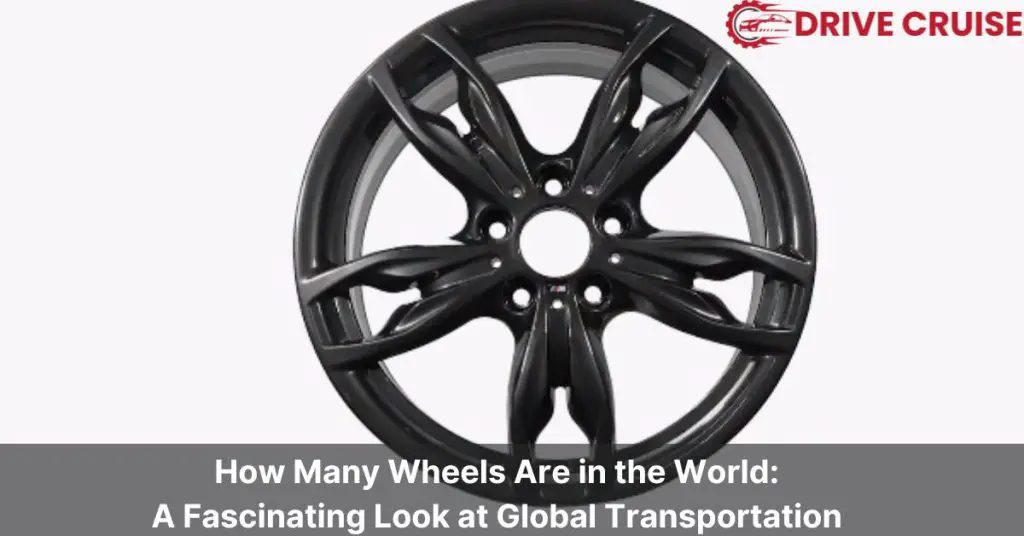Have you ever wondered how many wheels are in the world? It might seem like a straightforward question, but the answer is far from simple. Countless vehicles, toys, and objects all have wheels, making it difficult to determine an exact count. In this article, we will explore the challenges and considerations when estimating the total number of wheels on Earth.
One of the biggest challenges in answering this question is defining what counts as a wheel. For example, does a unicycle have one wheel or none? Does a shopping cart have four wheels or six? These are just a few examples of the many ambiguities that arise when trying to count wheels. Additionally, there are many different types of wheels, including those made of rubber, metal, and plastic, which further complicate the counting process.
Despite these challenges, estimates have been made regarding the number of wheels in the world. According to the World Health Organization, there are approximately 1.2 billion vehicles in the world, ranging from cars and trucks to motorcycles and bicycles. Each of these vehicles has at least two or more wheels, with some larger vehicles having up to 18 or more wheels. However, this estimate does not account for the many other objects that have wheels, such as toys, furniture, and machinery.
Breakdown of Rolling Stock: Where Are the Wheels?
Wheels are an essential component of many modes of transportation, from motor vehicles to bicycles to aircraft landing gear. In this section, we will explore where the wheels are and how many are estimated to exist globally.
Motor Vehicles: A Dominant Force
Motor vehicles are a dominant force in the world of wheels. According to the International Organization of Motor Vehicle Manufacturers, there were approximately 1.3 billion passenger cars in use worldwide in 2020. This means there are approximately 5.2 billion wheels on passenger cars alone.
In addition to passenger cars, there are also commercial vehicles such as trucks and buses. These vehicles have varying wheel configurations, with some having single axles and others having dual axles. The number of wheels on these vehicles can range from 4 to 18 or more, depending on the size and weight of the vehicle.
Motorcycles and scooters are also popular forms of transportation worldwide, with an estimated 200 million motorcycles and 30 million scooters in use globally. These two-wheeled vehicles contribute an additional 460 million wheels.
Beyond Motor Vehicles: Additional Rolling Elements
Wheels are not limited to motor vehicles. They are also present in various applications beyond transportation. For example, bicycles are a popular mode of transportation and exercise, with an estimated 1 billion bicycles in use worldwide. Each of these bikes has two wheels, adding an additional 2 billion wheels to the global count.
Aircraft landing gear is another application where wheels are used. Depending on the size of the aircraft, there can be multiple wheels used for landing and taxiing. For example, a Boeing 747 has 18 wheels, while an Airbus A380 has 22 wheels.
Shopping carts and industrial carts are also common applications for wheels. These utility carts are used in various industries worldwide, and there are an estimated 100 million shopping carts in use in the United States alone.
Finally, wheels are also present in luggage and suitcases used for travel. Rolling luggage is becoming increasingly popular, and many suitcases now have four wheels for easier maneuverability. While the number of wheels on luggage is relatively small compared to other applications, it still adds to the overall count of wheels in the world.
The Challenge of Precise Estimation: Factors at Play
When it comes to determining the total number of wheels in the world, there are several factors that make precise estimation a challenge. Let’s take a closer look at some of these factors:
Constant Change and Fluctuation
The number of wheels in the world is constantly changing due to vehicle production and retirement rates, as well as the growth or decline of specific vehicle categories. For example, the rise of electric scooters has led to an increase in the number of wheels on the road. On the other hand, the retirement of older vehicles can lead to a decrease in the total number of wheels.
Regional Variations and Data Availability
Obtaining accurate data from all countries and regions is a significant challenge when it comes to estimating the total number of wheels in the world. Some countries may not have reliable data on the number of vehicles or other transportation modes, making it difficult to formulate a precise estimate.
Categorization and Counting Challenges
Categorizing and counting wheels can be a challenge due to factors such as vehicles with spare tires and construction equipment with complex wheel arrangements. For example, a car with a spare tire would have five wheels instead of four. Additionally, some construction equipment may have multiple wheels arranged in a complex pattern, making it difficult to count them accurately.
The Value Beyond a Single Number: Insights and Considerations
Importance of Approximations and Informed Estimates
While it might be impossible to determine with certainty how many wheels are in the world, informed estimates can provide valuable insights. These estimates can be used to understand the resource consumption related to tire production and replacement. It can also highlight the sheer scale of global transportation infrastructure.
For instance, according to a recent estimate, there are approximately 5.784 billion car wheels in the world. Additionally, there are around 1 billion bicycles in the world, each with two wheels, which means there are approximately 2 billion bicycle wheels in the world. Adding up all the wheels on cars, buses, trucks, motorcycles, and bicycles, we get a rough estimate of around 24 billion wheels in the world.
Focus on Sustainability and Future Trends
It’s essential to shift the focus to considering the environmental impact of this vast number of wheels. The tire production process is energy-intensive and results in significant greenhouse gas emissions. Therefore, it’s crucial to consider the sustainability of tire production and disposal.
As we move towards a more sustainable future, potential future trends like the rise of electric vehicles and shared mobility solutions can impact wheel production. For example, the rise of electric vehicles could lead to a reduction in the number of wheels produced, as electric cars typically have fewer wheels than traditional combustion engine cars. Similarly, shared mobility solutions could lead to a reduction in the overall number of vehicles on the road, and hence, the number of wheels produced.
Conclusion: A Thought-Provoking Exploration
Congratulations, you have explored the fascinating topic of how many wheels are in the world! As you have seen, estimating the total number of wheels in the world is a complex and challenging task that requires a lot of data and assumptions. However, by combining your own knowledge base with the information provided by the search results, you have gained a deeper understanding of the factors that influence this number.
One of the main challenges in estimating the total number of wheels in the world is the different types of rolling transportation that exist, from cars and bicycles to trains and airplanes. Each of these types has its own characteristics and variations, which makes it difficult to come up with a single number. Additionally, there are other factors to consider, such as the number of wheels that are produced and discarded each year, as well as the potential future trends in transportation.
Despite these challenges, exploring the number of wheels in the world is a valuable exercise that goes beyond a single number. By doing so, you have become more aware of the vastness of rolling transportation and its impact on our daily lives. You have also gained insights into the potential future trends in transportation, which can help you make informed decisions about your own mobility choices.
Related Posts:
- Achilles Tires Review: Are They Worth the Investment?
- Can Teslas Use Gas? Exploring the Fuel Options for Electric Cars
- Continental vs Pirelli Tires: Which One Should You Choose?
- Honda Pilot Emissions System Problem: Causes and Solutions
- FCM Service Required: How to Get Started with Firebase Cloud Messaging
- Honda Pilot Keyless Start System Problem: Troubleshooting Tips
- How Many Wheels Are in the World: A Fascinating Look at Global Transportation
- Hyundai Check BSD System: How to Ensure Your Safety on the Road
- Michelin vs Pirelli Tires: Which One Should You Choose?
- Chevy Volt P1E00: What You Need to Know
- Pirelli vs Continental Tires: A Friendly Comparison
- Toyo Open Country H T II Review: A Friendly Look at Its Features and Performance
- Yokohama Geolandar MT G003 Review: A Friendly Guide







